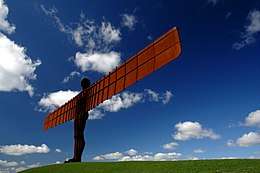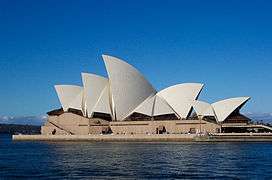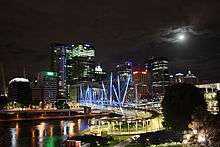Arup Group
Arup (officially Arup Group Limited) is a multinational professional services firm headquartered in London which provides engineering, architecture, design, planning, project management and consulting services for all aspects of the built environment. Founded by Sir Ove Arup in 1946, the firm has over 16,000 staff based in 96 offices across 35 countries around the world. Arup has participated in projects in over 160 countries.[3]
| Private, held in trust for the benefit of its employees | |
| Industry | Design, Engineering, Architecture and Business consultation |
| Predecessor | Arup & Arup Ltd (1938–1946) |
| Founded | 1 April 1946 |
| Founder | Sir Ove N. Arup |
| Headquarters | , |
Number of locations | +95 offices in 40 countries (2020) |
Area served | Worldwide |
Key people | Alan Belfield (Chairman) Tristram Carfrae (Deputy Chairman) |
| Services | Consultancy services |
| Revenue | |
| Total assets | |
Number of employees | |
| Subsidiaries | Ove Arup & Partners International Ltd, Arup Associates Ltd, and others. |
| Website | www |
Arup is owned by trusts, the beneficiaries of which are Arup's past and present employees, who receive a share of the firm's operating profit each year.[4]
History
Arup was founded in London in 1946, as the Ove N. Arup Consulting Engineers by Ove Arup. He set out to build a firm where professionals of diverse disciplines could work together to produce projects of greater quality than was achievable by them working in isolation. In 1970, the firm reformed as "Ove Arup & Partners". In 1963, together with the architect Philip Dowson, Arup Associates[5] was formed, this group continues to work under the banner of Arup Architecture following a streamlining of the Arup brand in 2018.
Notable projects
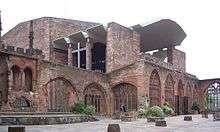
It is best known for its design work for the built environment.[6][7] Projects to which it has contributed include the Sydney Opera House, which is largely credited with launching Arup into the premier league of engineering consultancies.[8] The BBC and RIBA documentary The Brits who Built the Modern World highlighted Arup's collaboration with architects and described Arup as "the engineering firm which Lord Norman Foster and his peers Lord Richard Rogers, Sir Nicholas Grimshaw, Sir Michael Hopkins and Sir Terry Farrell most frequently relied upon."[9]
Africa
- Eastgate Centre, Harare, Zimbabwe (1996)
- Letsibogo Dam, Botswana (design and geotechnics, 1997)
- Constitutional Court, Johannesburg, South Africa (multidisciplinary engineers and project manager, 2004, architect: OMM)
- Scottish Livingstone Hospital, Molepolole, Botswana (design and construction supervision, 2007)
- Gautrain Rapid Rail Link Johannesburg to Pretoria, Sandton to OR Tambo International Airport, South Africa (concept studies and independent certification, 2010)
North America
- Apple Park is the corporate headquarters of Apple Inc., Cupertino, California, United States.
- Cathedral of Our Lady of the Angels, Los Angeles, USA (mechanical and electrical engineers, 2002, architect: Rafael Moneo)
- De Young Museum, San Francisco, USA (mechanical and electrical engineers, 2005, architects: Herzog & de Meuron)
- California Academy of Sciences, San Francisco, USA (structural and services engineers, 2008, architect: Renzo Piano)
- New Tappan Zee Bridge (Hudson River), New York City (concept studies, 2009)
- Bill & Melinda Gates Foundation Headquarters, Seattle, WA, USA (structural and services engineers, 2011, architects: NBBJ)
- Fulton Center, New York City, USA (structural engineers, 2014, HDR Daniel Frankfurt/Page Ayres Cowley Architects/Grimshaw Architects/Lee Harris Pomeroy Architects)
- High Roller, Las Vegas, NV, USA (structural and electrical engineering, 2014, architects: The Hettema Group and Klai Juba Architects)[10]
- Gerald Desmond Bridge Design-Build Project, Long Beach, California (civil, structural, geotechnical design services, ongoing)
- Second Avenue Subway, New York City, USA (tunnel engineering, ongoing)
- Lake Mead Intake No. 3, Nevada, USA (tunnel engineering)
- Champlain Bridge, Montreal , Qc, Canada (bridge design)
Asia
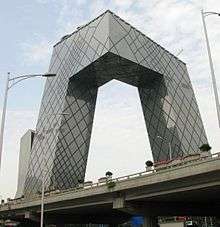
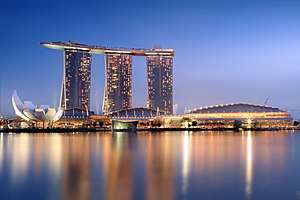
- Druk White Lotus School was built to survive the Ladakhi weather.
- Kingdom Centre, The third tallest skyscraper in Saudi Arabia, and the second tallest in Riyadh and an icon of it.
- HSBC Main Building, Hong Kong (civil and structural engineers, 1985, architects: Norman Foster)
- Kansai International Airport, Osaka, Japan (structural and services engineers, 1994, architect: Renzo Piano Building Workshop)
- Vattanac Capital Phnom Penh, Cambodia (structural engineers, 2014, architect: Farrells)
- Petron Megaplaza, Makati, Philippines (structural engineers, 1998, architect: Skidmore, Owings & Merrill)
- International Finance Centre, Hong Kong (structural and geotechnical engineers, 2003, Rocco Design Architects)
- National Aquatics Centre (Water Cube), Beijing, China (design and structural engineers, 2008, architects: PTW Architects/CSCEC/CCDI)
- Beijing National Stadium (the "Bird's Nest"), Beijing, China (structural engineers, 2008, architects: Herzog & de Meuron/China Architectural Design & Research Group/Ai Weiwei)
- CCTV Headquarters, Beijing, China (structural engineers, 2008, architects: Rem Koolhaas and Ole Scheeren/OMA)
- Fusionopolis, Singapore (structural and specialist engineers, 2008, architects: Kisho Kurokawa)
- Rajiv Gandhi International Airport, Hyderabad, Telangana, India (full engineering services, 2008, architect: Integrated Design Associates)
- Singapore Flyer, Singapore (structural engineers, 2008, architects: Kisho Kurokawa/DP)
- Stonecutters Bridge, Hong Kong (bridge engineers, 2009, architect: Dissing+Weitling)
- Dongtan, Shanghai, China (design and masterplan, 2010, main designer: Thomas V. Harwood III)
- Canton Tower, Guangzhou, China (structural engineers, 2010, architects: Mark Hemel/Barbara Kuit/IBA)
- King Power MahaNakhon, Bangkok, Thailand (structural engineers 2016, architects: Ole Scheeren)
- Marina Bay Sands Integrated Resort, Singapore (structural and specialist engineers, 2010, architects: Moshe Safdie/Aedas)
- The Helix, Singapore (structural, civil, maritime, mechanical, electrical engineers, lighting designers 2010, architects: Cox Architects/a61)
- Singapore Sports Hub, Singapore (structural and specialist engineers, 2010, architects: Arup Associates (Arup Sport)/DP Architects)
- Capitol Development, Singapore (structural, civil, mechanical, electrical, facade, fire engineers, sustainability and vertical transportation consultants 2015, architects: Richard Meier & Partners/a61)
- Tanjong Pagar Centre, Singapore (structural and facade engineers, sustainability consultants 2016, architects: Skidmore, Owings & Merrill LLP)
- Taiwan Taoyuan International Airport, Taiwan Taoyuan International Airport, Terminal 3, Taiwan (expected to be opened in 2020)
- Aldar Headquarters building, Abu Dhabi, rounded skyscraper (2009)
Australia
- Sydney Opera House, Sydney, Australia (structural engineers, 1973, architect: Jørn Utzon)
- Melbourne Museum, Melbourne, Australia (civil and structural engineers, 2000, architects: Denton Corker Marshall)
- Swan Bells, Perth, Australia (structural engineers, 2000, architects: Hames Sharley)
- Goodwill Bridge, Brisbane, Australia (bridge design, 2001, architects: Cox Rayner)
- National Museum of Australia, Canberra, Australia (structural engineers, 2001, architects: Howard Raggatt)
- Lang Park redevelopment, Brisbane, Australia (masterplanning, civil and structural engineers, 2003, architects: Populous/PDT)
- National Gallery of Victoria, Melbourne, Australia (structural engineers, 2003, architects: Mario Bellini)
- State Library of Victoria, Melbourne, Australia (structural engineers, 2004, architects: Ancher Mortlock & Woolley)
- Melbourne Cricket Ground, Melbourne, Australia (civil and structural engineers, 2005, architects: MCG5)
- Australian Synchrotron, Melbourne, Victoria (specialist engineering, 2007)
- Kurilpa Bridge, Brisbane, Australia (bridge design, 2009, architects: Cox Rayner)
- Melbourne Recital Centre & Melbourne Theatre Company Theatre, Melbourne, Australia (acoustic and theatre engineers, 2009, architects: Ashton Raggat McDougall)
- Andrew "Boy" Charlton Pool, Sydney, Australia (structural and services engineering, 2011, architects: Lippmann Associates)
- Melbourne Star, Melbourne, Australia (structural engineering, 2013)
- Perth Stadium, Perth, Australia (civil and structural engineering, 2017, architects: Hassell, HKS, Cox)
Europe
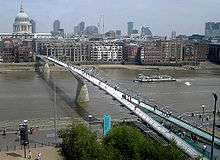
- Light House (London), London, UK (environmental and structural engineering)
- Coventry Cathedral, UK (structural engineers, 1962, architect: Sir Basil Spence)
- Kingsgate Bridge, Durham, UK (engineering design, 1966)
- Preston Bus Station, Lancashire, UK (structural engineering, 1969)
- Greyfriars Bus Station, Northampton, UK (engineering design, 1976)
- Pompidou Centre, Paris, France (structural and service engineers, 1977, architects: Renzo Piano & Richard Rogers)
- The Barbican Centre, London, UK (civil and structural engineers, 1982, architects: Chamberlin, Powell and Bon)
- Lloyds Building, London, UK (building engineers and project planners, 1986, architect: Richard Rogers)
- Angel of the North, Gateshead, UK (advanced structural research, 1998, designer: Antony Gormley)
- London Eye, London, UK (structural engineers, 2000, architect: Marks Barfield)[11]
- Millennium Bridge, London, UK (bridge engineering, 2000, architects: Foster + Partners and Sir Anthony Caro)
- Øresund Bridge, Denmark / Sweden (planning and bridge engineering, 2000, architects: Dissing+Weitling)
- Sony Center, Berlin, Germany (structural and environmental engineers, 2000, architect: Helmut Jahn)
- HSBC Tower, London, London, UK (structural engineers, 2002, architects: Foster + Partners)
- City of Manchester Stadium, Manchester, England, UK (Arup Associates architects, 2002)
- Selfridges, Birmingham, UK (structural engineers, 2003, architect: Future Systems)
- 30 St Mary Axe ("The Gherkin"), London, UK (structural engineers, 2004, architect: Norman Foster)
- Scottish Parliament Building, Edinburgh, Scotland, UK (structural, civil, façade, geotechnical, blast and landscaping engineers, 2004, architect: Enric Miralles)
- Allianz Arena, Munich, Germany (structural engineers, 2005, architects: Herzog & de Meuron)
- Arnolfini refurbishment, Bristol, England, UK (structural, mechanical and electrical engineers, 2005, architects: Snell Associates)
- Casa da Música, Porto, Portugal (building engineers, 2005: architects: Rem Koolhaas/OMA)
- Restoration programme of Brunel's SS Great Britain, Bristol, England, UK (civil and structural engineers, 2005, architect: Alex French Partnership)
- Kanyon Shopping Mall, Istanbul, Turkey (structural engineers, 2006, architect: Tabanlıoğlu Architects)
- Nescio Bridge, Amsterdam, Netherlands (structural engineers, 2006, architect: Wilkinson Eyre)
- High Speed 1, UK (rail engineering, 2007)
- Terminal 5 at Heathrow Airport, England, UK (civil engineers, 2008, architect: Richard Rogers)
- Ahmed Adnan Saygun Arts Center, İzmir, Turkey (acoustic consulting, 2008, architect: Tozkoparan Architecture)[12]
- Snowdon Summit Building, Wales, UK (structural engineers, 2009, Ray Hole Architects)
- Donbass Arena, Ukraine (structural engineers, 2009)
- Grand Canal Theatre, Dublin, Ireland (acoustic, theatre technical, structural and building services engineers, 2010, architect: Daniel Libeskind)
- London Aquatics Centre, London, UK (structural and services engineers, 2012, architect: Zaha Hadid)
- Shard London Bridge, London, UK (services engineers, 2013, architect: Renzo Piano)
- Sky Studios, London, UK (Arup Associates architects, 2013)
- Nou Mestalla Stadium, Valencia, Spain (structural engineers, ongoing, architects: Reid Fenwick Asociados)
- Seat of the European Central Bank, Frankfurt, Germany (building services engineers, ongoing, architect: Coop Himmelb(l)au)
- Lakhta Center, Saint Peterburg, Russia (verification calculation for the underground part, foundation pile base and the superstructure, ongoing, architect: Tony Kettle, RMJM)
Sports
Arup had its own sports division, Arup Sport, specialising in designing, consulting and structural engineering for sporting facilities such as stadia.[13] This group continues to work under the banner of Arup Architecture following a streamlining of the Arup brand. Many of Arup's modern stadia are designed with a contemporary, distinctive edge and the company strives to revolutionise stadium architecture and performance.[13] For instance, the Bird's Nest Stadium for the 2008 Olympics was complimented for its striking architectural appearance[14] and the City of Manchester Stadium for the 2002 Commonwealth Games has stairless entry to the upper tiers through circular ramps outside the stadium.[13] The most notable stadium projects led by Arup remain the City of Manchester Stadium (2002), Allianz Arena (2005), Beijing National Stadium (2008), Donbass Arena (2009) and the Singapore Sports Hub (2014).

.jpg) Allianz Arena in Germany, home of FC Bayern Munich
Allianz Arena in Germany, home of FC Bayern Munich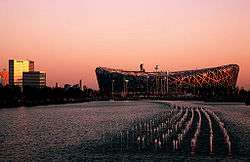 The 'Bird's Nest or Beijing National Stadium, for 2008 Summer Olympics, Beijing and national stadium of China
The 'Bird's Nest or Beijing National Stadium, for 2008 Summer Olympics, Beijing and national stadium of China
Awards
Arup's multidisciplinary sports venue design and engineering scope on the Singapore Sports Hub won the 2013 World Architecture Festival Award in the Future Projects, Leisure Category.
The Casa da Música, Oporto, designed by Arup and Office for Metropolitan Architecture was nominated for the 2007 Stirling Prize.
Arup's work with The Druk White Lotus School, Ladakh, won them Large Consultancy Firm of the Year 2003 at the British Consultants and Construction Bureau – International Expertise Awards, 2003 building on their triple win at the 2002 World Architecture Awards.[15]
Arup was awarded the Worldaware Award for Innovation for its Vawtex air system in Harare International School.[16]
Arup Fire has won the Fire Safety Engineering Design award four times since its creation in 2001.[17] The 2001 inaugural award was won for Arup's contribution to the Eden Project in Cornwall, UK, the world's largest greenhouse. In 2004, the design for London's City Hall was appointed joint winner. In 2005, the Temple Mills Eurostar Depot won. The 2006 winning entry was for Amethyst House, a nine-storey building with an atrium from the ground to the top, in Manchester, UK.[18] More recently, Dr Barbara Lane, Associate Director with Arup, won the Royal Academy of Engineering Silver Medal[19] for her outstanding contribution to British engineering on design of structures for fire.
Arup was also awarded Royal Town Planning Institute Consultancy of the year award in 2008.
Mike Glover is the recipient of the 2008 Institution of Structural Engineers' Gold Medal.
Arup was awarded the 2010 Live Design Excellence Award for Theatre Design for the integrated theatre and acoustic team's design for the new Jerome Robbins Theatre, created for Mikhail Baryshnikov and The Wooster Group.[20]
The Evelyn Grace Academy, London designed by Zaha Hadid Architects and Arup won the prestigious RIBA Stirling Prize 2011.
Arup was named Tunnel Design Firm of the Year at the 2012 ITA AITES International Tunnelling Awards.
Criticism
Some buildings designed by Arup Group are considered worthy of demolition by the public. For example Scottish Parliament Building and Greyfriars Bus Station were included in "The Dirty Dozen" for the Channel 4 programme Demolition.
Fellows
Arup Fellow is a lifelong honorary title awarded to selected honorary individuals in the firm. It acknowledges the highest design and technical achievements of people, not only within the firm, but also in the industry as a whole. They are considered role models who possess world-class expertise who put theory into effective practice.
The current fellows, as of November 2019, are:[21]
- Davar Abi-Zadeh
- Michael Beaven
- Peter Burnton
- David Caiden
- Helen Campbell
- Tristram Carfrae
- Vincent Cheng
- Alice Chow
- Sam Chow
- Mark Chown
- Fiona Cousins
- Jo da Silva OBE
- Graham Dodd
- Ian Feltham
- Mark Fletcher
- Marianne Foley
- Ian Gardner
- Craig Gibbons
- Peter Gist
- Mike Glover OBE
- Richard Greer
- Alistair Guthrie
- Goman Ho
- Richard Hornby
- Jon Hurt
- Naeem Hussain
- Paul Johnson
- Peter Johnson
- Florence Lam
- Barbara Lane
- Wilfred Lau
- Chris Luebkeman
- Erin McConahey
- Rory McGowan
- Alisdair McGregor
- Tateo Nakajima
- Duncan Nicholson
- Nick O'Riordan
- Raj Patel
- Mahadev Raman
- Rudi Scheuermann
- Andy Sedgwick
- Brian Simpson OBE
- Paul Sloman
- Malcolm Smith
- Richard Sturt
- Tim Suen
- Corinne Swain OBE (d. 2020)[22]
- Tony Vidago
- Regine Weston
- Michael Willford
- Atila Zekioglu
Notable alumni and current staff
- Sir Ove Nyquist Arup (1895–1988), structural engineer and philosopher, founder of the company, recipient of the RIBA Royal Gold Medal for Architecture 1966, Institution of Structural Engineers Gold Medal 1973.
- Peter Dunican (1918–1989), structural engineer, first chairman of Ove Arup Partnership (1977–1984), and President of the Institution of Structural Engineers in 1977 and 1978.
- Sir Jack Zunz (1923–2018), civil engineer, and principal structural designer of the Sydney Opera House, IStructE Gold Medal 1988.
- Sir Philip Dowson (1924–2014), architect, founding partner of Arup Associates, Royal Gold Medal 1981, and President of the Royal Academy 1993–1999.
- Povl Ahm (1926–2005), structural engineer, principal engineer for Coventry Cathedral, and chairman of Ove Arup & Partners 1984–1992.
- Professor Sir Ted Happold (1930–1996), structural engineer, executive partner for the Pompidou Centre, and founder of Buro Happold in 1976.
- Peter Rice (1935–1992), structural engineer, responsible for the roof geometry of the Sydney Opera House and the build project for the Pompidou Centre.
- Dr Edmund Hambly (1942–1995), structural engineer, and president of the Institution of Civil Engineers 1994–1995.
- Cecil Balmond (1943–), structural engineer, founder of Arup's Advanced Geometry Unit, lead designer for the Centre Pompidou-Metz, the CCTV tower in Beijing, the Ito-Balmond Serpentine Pavilion, and the ArcelorMittal Orbit.
- Steven Groák (1944–1998) head of research and development at Ove Arup Partnership from 1990–1998.
- Mike Glover (1946–), civil and structural engineer, and Technical Director for the Channel Tunnel Rail Link, IStructE Gold Medal 2008.
- Tony Fitzpatrick (1950–2003), structural engineer, and leader of the Millennium Bridge damping project.
- Sir Philip Dilley (1955–), civil engineer, Arup Group chairman 2009–2014, Chairman of London First, Chairman of the Infrastructure and Urban Development Community at the World Economic Forum.
- Professor Chris Wise (1956–), structural engineer, and later Professor of Creative Design at Imperial College. He was one of the founders of Expedition Engineering in 1999.
- Nille Juul-Sørensen (1958–), renown global product designer and recipient of the prestigious Elefantordenen from Margrethe II.
- Tristram Carfrae (1959–), IStructE Gold Medal 2014.
- Tim Jarvis (1966–), environmental scientist, author and explorer.
- Jo da Silva (1967–), IStructE Gold Medal 2017.
- Rogier van der Heide (1970–), lighting designer, and former leader of Arup's lighting consultancy, and later Chief Design Officer at Philips Lighting.
Related companies
A number of its staff have left to form other companies, often with significant parallels with Arup.
In 1976, Edmund Happold (engineer for the Pompidou Centre) and six other engineers left Arup to form Buro Happold in Bath. Mark Whitby left Buro Happold to form Whitby Bird.
In 1999, Chris Wise (engineer for the Millennium Bridge) and Sean Walsh left Arup to form Expedition Engineering in London.
References
- "Financial statements 2018". arup.com. Retrieved 26 April 2019.
- https://www.arup.com/our-firm
- "Arup Ownership & finance". The Arup Group. Archived from the original on 25 March 2007. Retrieved 26 March 2007.
- "Arup Structure". The Arup Group. Archived from the original on 1 November 2009. Retrieved 25 November 2009.
- Arup Associates Archived 10 October 2007 at the Wayback Machine
- Ove Arup & Partners 1946–1986. London: Academy Editions. 1986. ISBN 0-85670-898-4.
- Campbell, Peter; Allan, John; Ahrends, Peter; Zunz, Jack; Morreau, Patrick (1995). Ove Arup 1895–1988. London: Institution of Civil Engineers. ISBN 0-7277-2066-X.
- Jones, Peter (2006). Ove Arup, Master Builder of the Twentieth Century. New Haven, CT: Yale University Press. ISBN 978-0-300-11296-2.
- "The Politics of Power". The Brits who Built the Modern World. London. 27 February 2014. BBC Four.
- "High Roller Observation Wheel". London: Arup. Retrieved 17 June 2014.
- "The Singapore Flyer and design of Giant Observation Wheels"Brendon McNiven & Pat Dallard, IStructE Asia-Pacific Forum on Structural Engineering: Innovations in Structural Engineering, Singapore, 2 – 3 November 2007
- "Ahmed Adnan Saygun Arts Centre". arup.com. Retrieved 9 September 2018.
- "Arup Sport". arup.com. Retrieved 29 August 2011.
- Rayner, Gordon (7 August 2008). "Beijing Olympics: The Bird's Nest stadium". The Telegraph. Retrieved 29 August 2011.
- "World Architecture Awards" (Press release). Arup. 5 August 2002. Archived from the original on 10 March 2007. Retrieved 27 March 2007.
- "The Worldaware Award for Innovation". Worldaware. 2002. Archived from the original on 21 February 2007. Retrieved 27 March 2007.
- "Innovation key to FSE Design Award winners". FSE: Fire Safety Engineering. 15 November 2006. Retrieved 27 March 2007.
- "Fire Safety Engineering Design Awards". Arup. 8 November 2006. Archived from the original on 21 February 2007. Retrieved 27 March 2007.
- "Less is more for fire protection". Royal Academy of Engineering. 5 June 2008. Retrieved 3 July 2008.
- "Live Design's Excellence in Live Design Award (Theatre)". Live Design/Penton Media. 2010. Archived from the original on 7 May 2010. Retrieved 23 March 2010.
- "Arup Fellows". arup.com. 11 November 2019. Retrieved 11 November 2019.
- Sue Manns, "Presidential team continues to raise profile of planning", RTPI, 17 March 2020. Retrieved 31 March 2020
External links
| Wikimedia Commons has media related to Arup (buildings and structures). |
